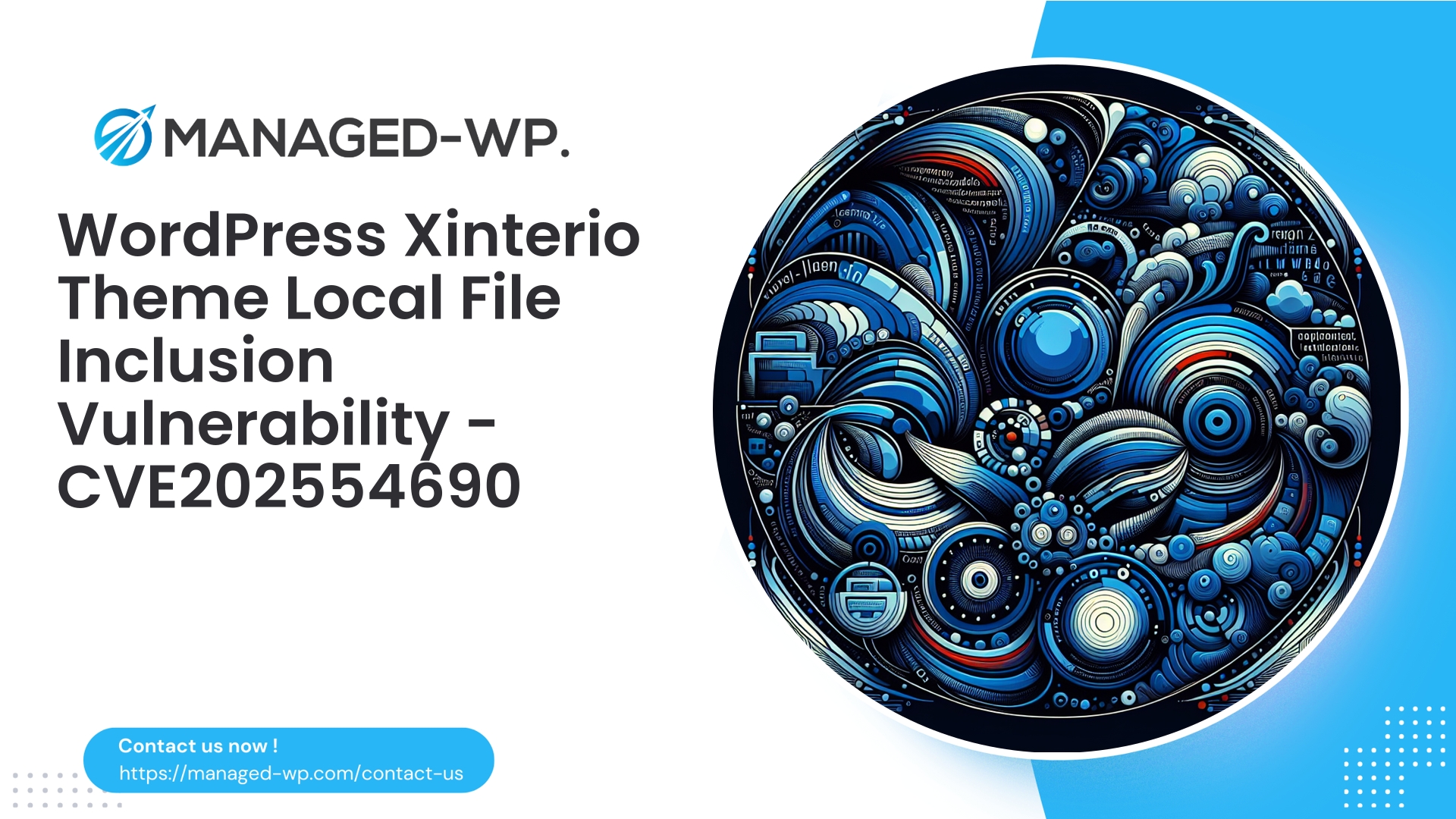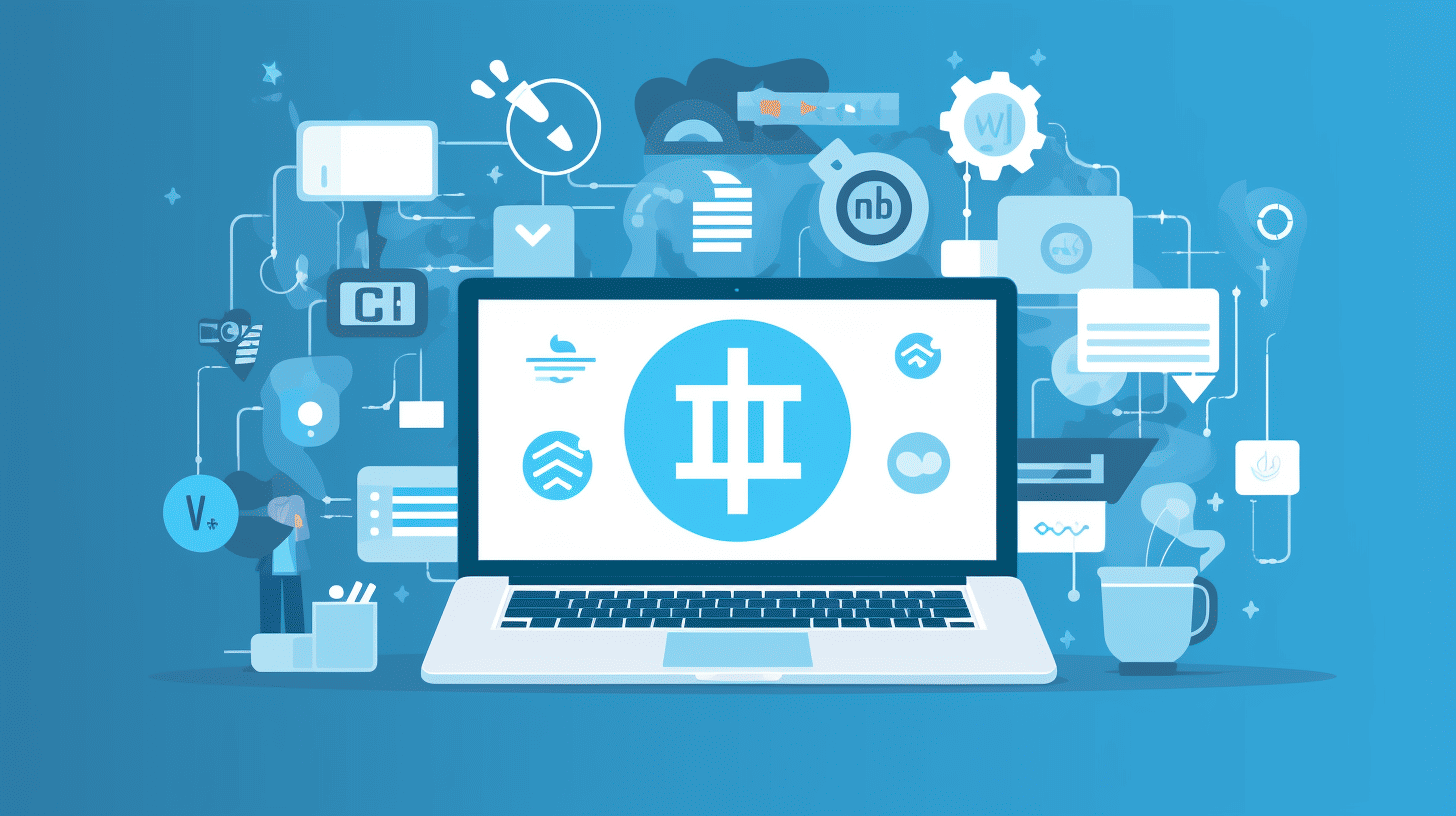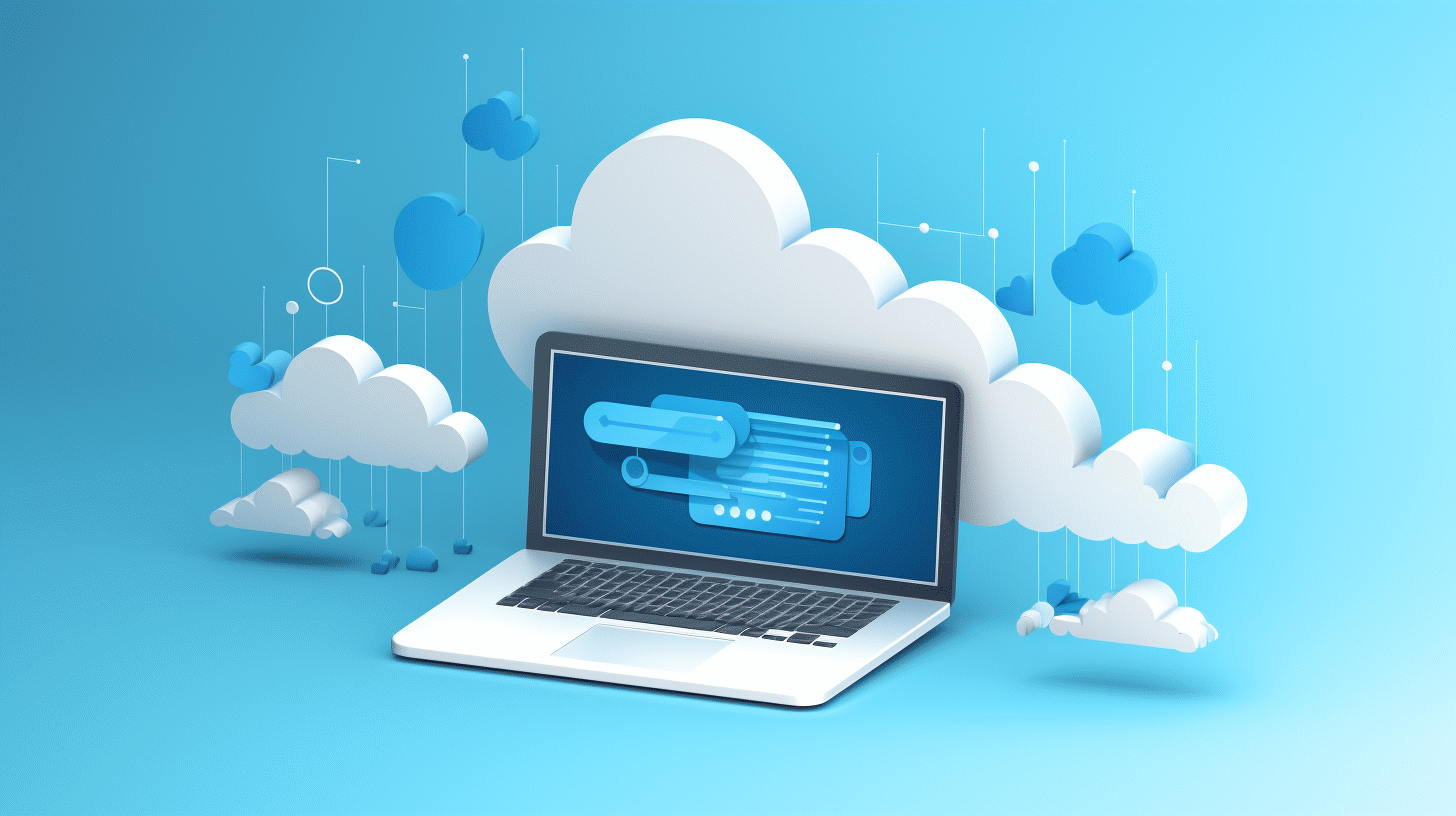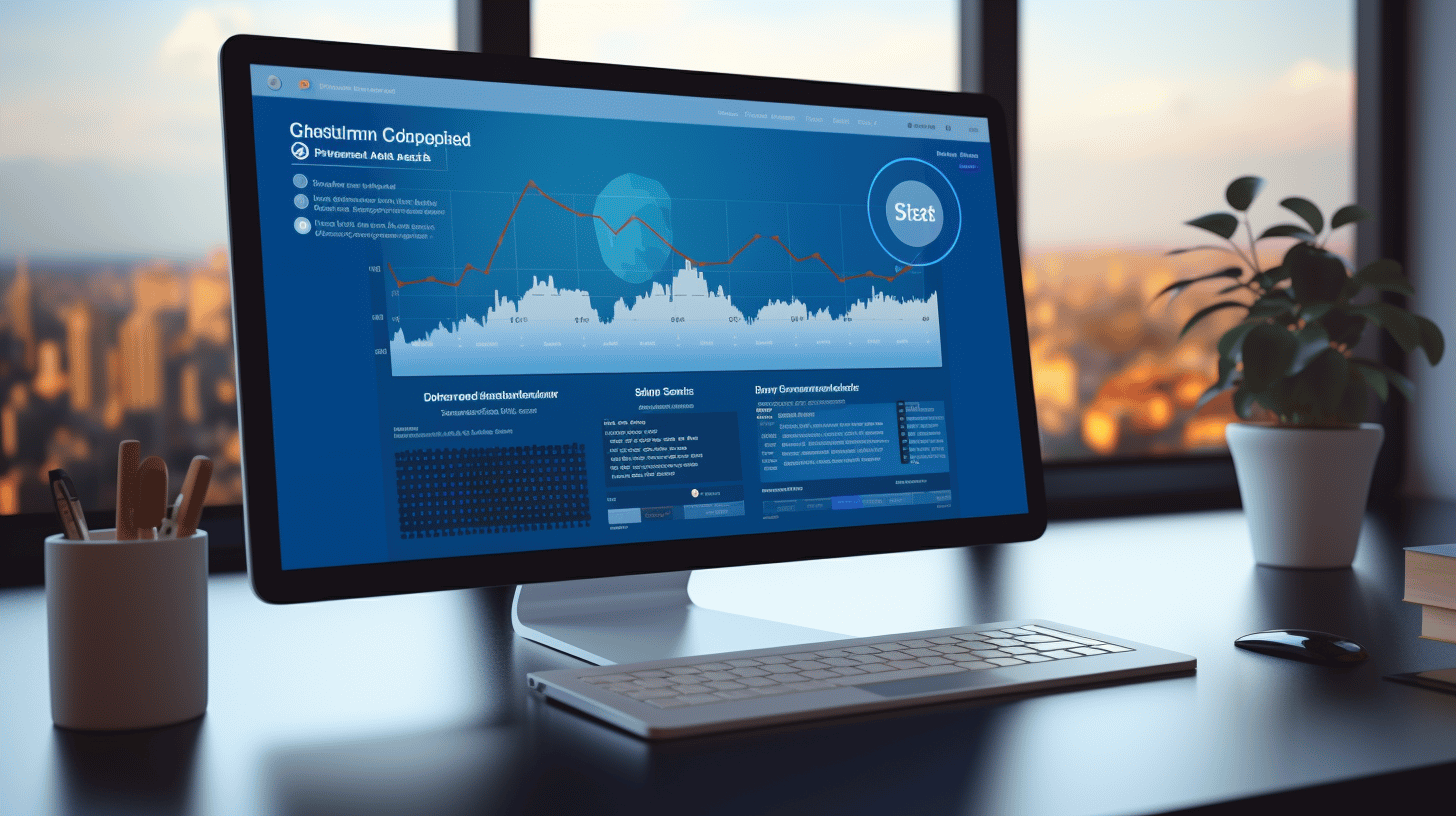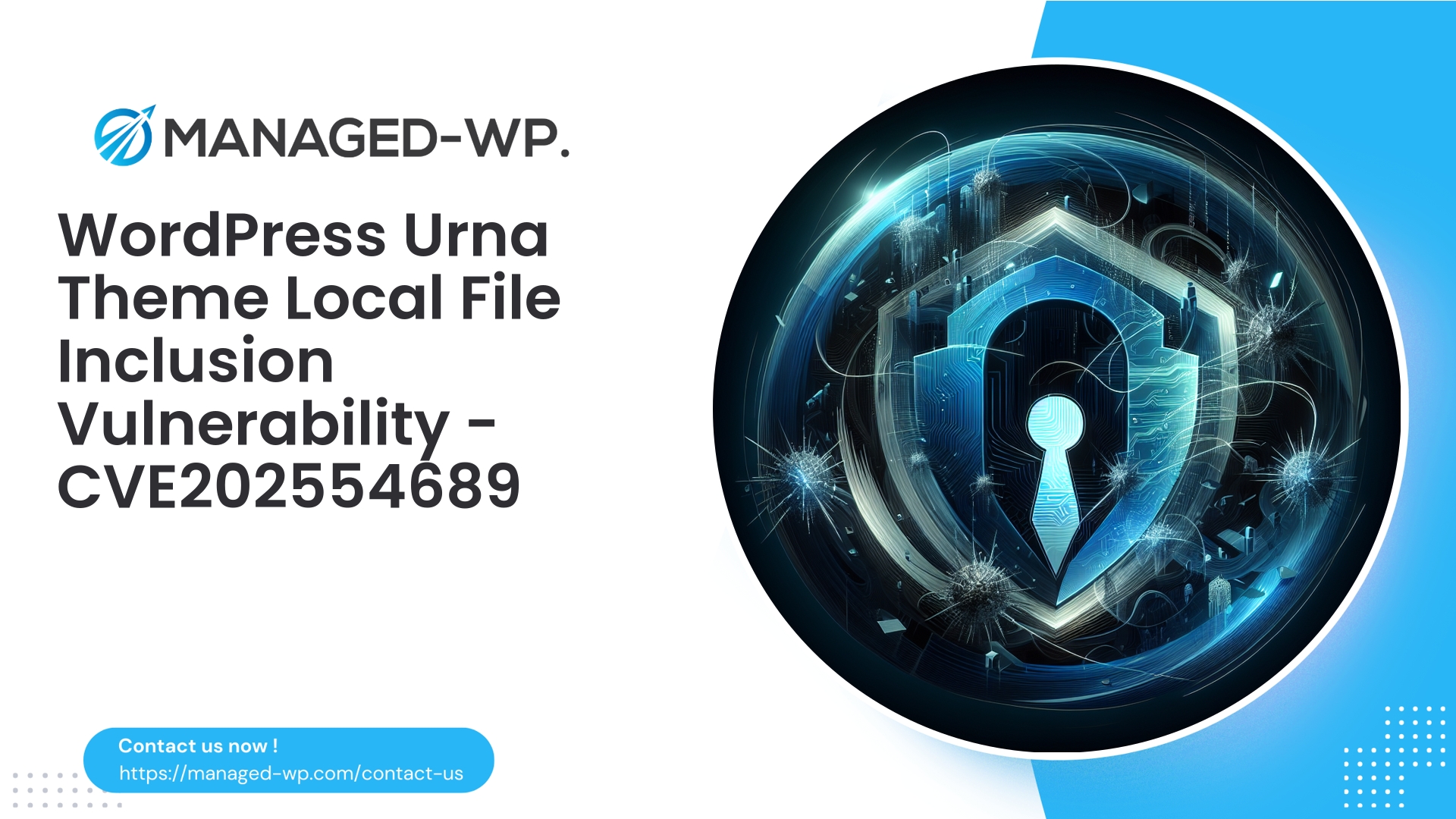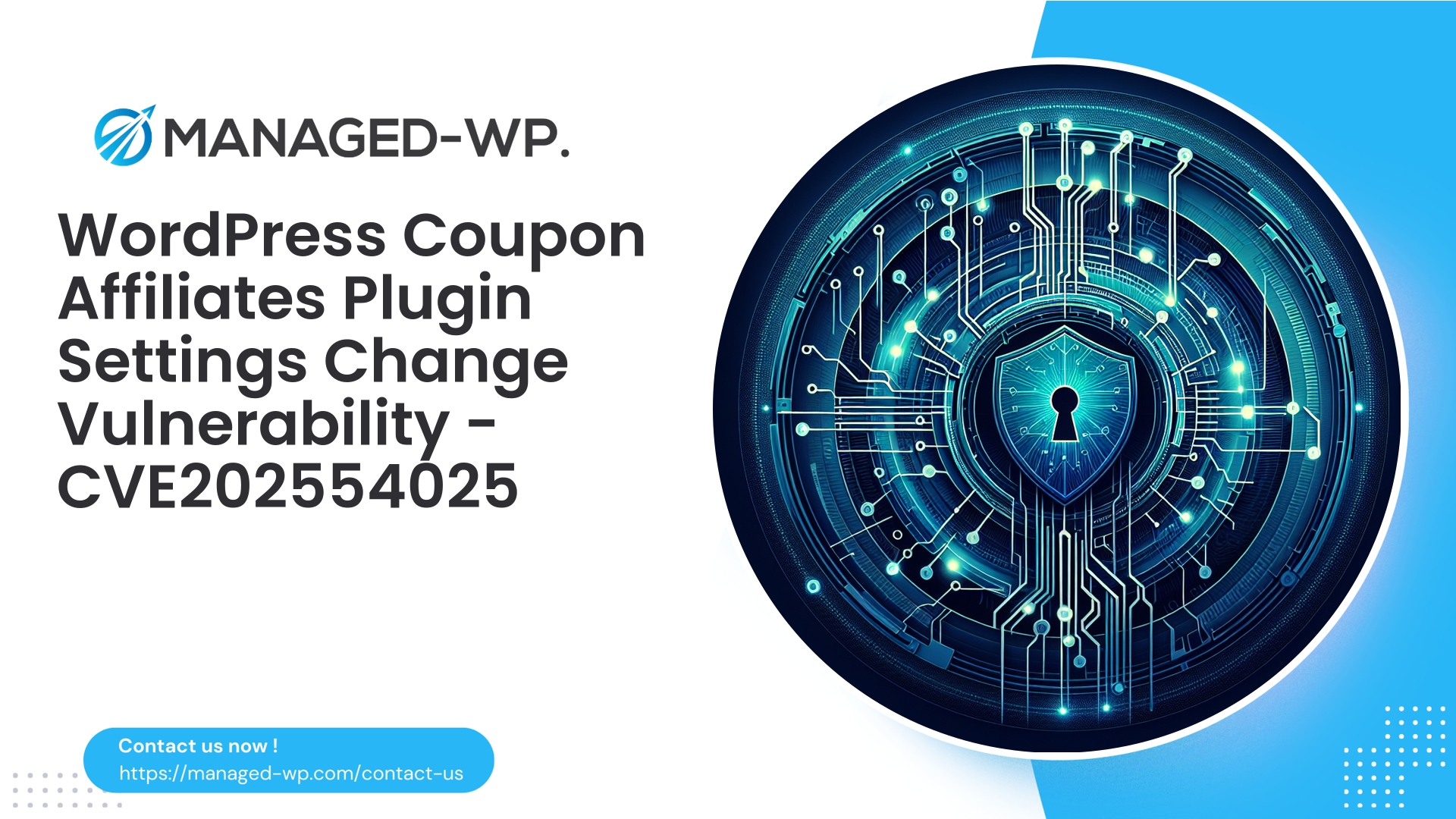| Plugin Name | Xinterio |
|---|---|
| Type of Vulnerability | Local File Inclusion (LFI) |
| CVE Number | CVE-2025-54690 |
| Urgency | High |
| CVE Publish Date | 2025-08-06 |
| Source URL | CVE-2025-54690 |
Critical Local File Inclusion Vulnerability Discovered in Xinterio Theme (≤ 4.2): A Security Advisory for WordPress Site Owners
As cybersecurity professionals in the United States specializing in WordPress security, Managed-WP brings you the latest intelligence on a critical Local File Inclusion (LFI) flaw impacting the widely used Xinterio WordPress theme, versions 4.2 and earlier. This vulnerability poses a significant risk, potentially enabling attackers to access sensitive files, exfiltrate credentials, and compromise your entire website infrastructure.
In this detailed advisory, you will be equipped with expert-level insights to understand the nature of LFI vulnerabilities, assess the specific dangers posed by this threat, and implement the necessary countermeasures to ensure your site’s integrity and resilience.
Understanding Local File Inclusion (LFI) and Its Security Implications
Local File Inclusion (LFI) is a web security vulnerability that tricks a web application into loading files from the local server file system. Unlike Remote File Inclusion, LFI confines the attack to files already present on your server, which can include highly sensitive data.
Exploitation of an LFI vulnerability can allow malicious actors to:
- Access and read sensitive files such as
wp-config.php, which contain database credentials. - Reveal server configuration files including
.htaccessand system files like/etc/passwd. - Escalate attacks potentially leading to remote code execution and full site takeover.
- Deface web content or inject malicious scripts.
- Pivot to compromise other websites hosted on the same server.
Key takeaway: If your WordPress site runs Xinterio theme version 4.2 or below, you face an elevated risk that must be addressed immediately.
Xinterio Theme Vulnerability Details
| Attribute | Details |
|---|---|
| Affected Software | WordPress Xinterio Theme |
| Vulnerable Versions | ≤ 4.2 |
| Fixed in Version | 4.3 |
| Vulnerability Type | Local File Inclusion (LFI) |
| CVE ID | CVE-2025-54690 |
| CVSS Score | 8.1 (High Severity) |
| Disclosure Date | August 6, 2025 |
| Reported By | Security Researcher Tran Nguyen Bao Khanh |
| Exploit Complexity | No authentication or privileges required |
| Patch Priority | Critical |
This flaw allows unauthenticated attackers to exploit theme parameters to include arbitrary files from the WordPress server host. In a shared hosting environment, this elevates risks beyond individual sites, potentially threatening all websites residing on the same infrastructure.
Why This Vulnerability Demands Immediate Attention
- Exposure of sensitive credentials: Accessing
wp-config.phpcompromises your database connection details directly. - Launchpad for further attack vectors: Obtained data can lead to command execution or privilege escalation.
- Automated widespread attacks: Cybercriminal groups frequently scan for such vulnerabilities en masse, facilitating rapid exploitation.
Technical Overview of the Exploit
This vulnerability results from insufficient sanitization of user input parameters that influence theme resource loading mechanisms. Attackers craft specially designed URLs that include directory traversal sequences (../) to reference and load files outside intended directories.
Illustrative example:
https://yourwebsite.com/?template=../../../wp-config
This input tricks the theme into improperly including wp-config.php, exposing critical secrets.
Underlying cause: use of dynamic include or require statements within theme code tied to unvalidated GET/POST input.
Documented Consequences from Exploited Sites
Real-world incidents involving LFI exploits within WordPress environments have resulted in:
- Data breaches with full database exports or deletions.
- Unauthorized administrator logins.
- Website defacements and malware injection.
- Account suspensions due to malicious outbound traffic.
This event underlines the importance of validating and patching all components in your WordPress ecosystem proactively.
Recommended Immediate Actions
1. Verify Your Exposure
- Confirm whether your site uses the Xinterio theme and identify its version.
- Inside your WordPress admin dashboard or via FTP, locate the theme folder and check the stylesheet header or version indicator files.
2. Apply the Security Patch Without Delay
- Update Xinterio theme to version 4.3 or newer immediately.
- Create a full backup before updating to ensure recovery capability.
Delaying updates puts your site at serious risk given ongoing automated LFI scanning and exploitation campaigns.
3. Perform a Comprehensive Security Audit
- Analyze logs for unusual requests or error messages related to file inclusions.
- Scan your website files for unauthorized changes or malware.
- Check for unknown admin users or suspicious account activities.
4. Strengthen Security Posture with Managed Firewall Solutions
- Deploy a managed Web Application Firewall (WAF) capable of detecting and blocking LFI payloads.
- Employ virtual patching to shield against unpatched vulnerabilities during update windows.
5. Maintain Regular Backup Protocols
- Utilize automated off-site backups to ensure rapid restoration after any compromise.
Why Sole Reliance on Malware Scanners and Generic Security Plugins Falls Short
Traditional malware detection tools generally identify known threat signatures or outdated components but:
- LFI exploits may not generate detectable malware files on the server.
- Exploit payloads often operate without leaving direct artifacts, hence evade signature-based detection.
- Attacks leveraging LFI aim to retrieve/configure data or execute code remotely without traditional malware installation.
Robust protection demands real-time request filtering, proactive virtual patching, and continuous monitoring beyond after-the-fact scanning.
Virtual Patching: An Essential Layer of Defense
Virtual patching allows immediate deployment of security rules blocking exploitation attempts, even before official patches or upgrades can be applied. This layer acts as a critical stopgap, minimizing exposure during the patch deployment cycle.
- Delivers instant mitigation against recognized attack signatures.
- Requires no modifications to theme or plugin codebase.
- Reduces risk exposure and buying time for thorough testing and rollout of permanent fixes.
For affected Xinterio users, virtual patching blocks LFI attempts straightaway, safeguarding your environment while you update.
How a Managed WordPress Firewall Safeguards Your Site From LFI Threats
A professional managed WordPress firewall service offers the following capabilities:
- Incoming request inspection: Detect and intercept payloads featuring directory traversal or unsafe file inclusion patterns.
- OWASP Top 10 threat defense: Neutralizes common vulnerabilities like injection flaws including LFI.
- Real-time malware scanning: Identifies infection indicators promptly.
- IP reputation management: Enforces blacklists/whitelists to curb brute force and repeated probes.
- Custom rule sets: Tailored filtering to your site architecture and usage behavior.
This multi-layered approach prevents exploitation attempts and reduces attack surface exposure comprehensively.
If Your Site Has Been Compromised: Steps for Incident Response
- Immediately isolate the compromised environment to stop further intrusion or propagation.
- Engage qualified security experts or your hosting provider for forensic investigation and cleanup.
- Avoid relying on simple theme/plugin removals alone — infection may persist elsewhere.
- Reset all administrative credentials and review user privileges prudently.
- Verify and tighten file and directory permissions to minimize attack vectors.
- Restore your site from a verified clean backup if necessary.
- Apply the theme update (version 4.3+) with urgency.
- Closely monitor your site post-remediation for indicators of reinfections or backdoors.
Adopting a Holistic Security Framework for Your WordPress Ecosystem
Reactive patching is insufficient to maintain security integrity. Managed-WP recommends a strategic approach encompassing:
- Timely updates: WordPress core, themes, and plugins kept current.
- Comprehensive firewalls and firewall management: To block threats pre-emptively.
- Multi-factor authentication and strong password policies.
- Minimum necessary privileges: Enforce strict role and capability restrictions.
- Automated, regular backups: Ensuring rapid restoration capabilities.
- Continuous monitoring and alerts: Staying vigilant to new threats and anomalies.
Stay Ahead: Proactive Defense is Crucial
The exposure of an LFI vulnerability in the Xinterio theme is a sobering reminder that WordPress site security demands constant attention and layered defenses. Attackers utilize automated tools that scan global domains relentlessly.
Combining advanced firewall technology, comprehensive malware detection, and virtual patching significantly reduces your site’s attack surface and response time to emerging threats.
Start Protecting Your WordPress Site Today with Managed-WP’s Free Security Plan
Our US-based security experts have crafted an accessible, robust solution for site owners who seek essential protection with minimal hassle.
Features of Managed-WP Free Security Plan
- Enterprise-grade managed firewall with automatic filtering of LFI and other attack payloads.
- Unlimited bandwidth protection safeguarding visitor experience.
- Web Application Firewall (WAF) enforcing OWASP Top 10 safeguards.
- Continuous malware scanning and threat detection.
Enroll now for Managed-WP’s free security plan →
Upgrade options unlock advanced malware removal, IP management, security reporting, and bespoke virtual patching for high-security environments.
Final Assessment
Security incidents like the Xinterio theme LFI vulnerability highlight the unforgiving nature of web threats and the necessity for immediate and decisive action. Updating your theme is paramount, but it must be combined with proactive defenses such as managed firewalls and virtual patching to maintain a secure WordPress presence.
Remember—WordPress security is continuous. By partnering with Managed-WP, you gain the peace of mind that expert protection is standing guard around the clock.
Additional Resources & Reading
- WordPress Security Best Practices
- OWASP Top 10 Web Application Risks
- CVE-2025-54690 Details
- Understanding File Inclusion Vulnerabilities
Your WordPress site’s security is Managed-WP’s mission. Take the first step toward robust, expert-managed protection today with our free plan designed specifically for proactive site owners.











